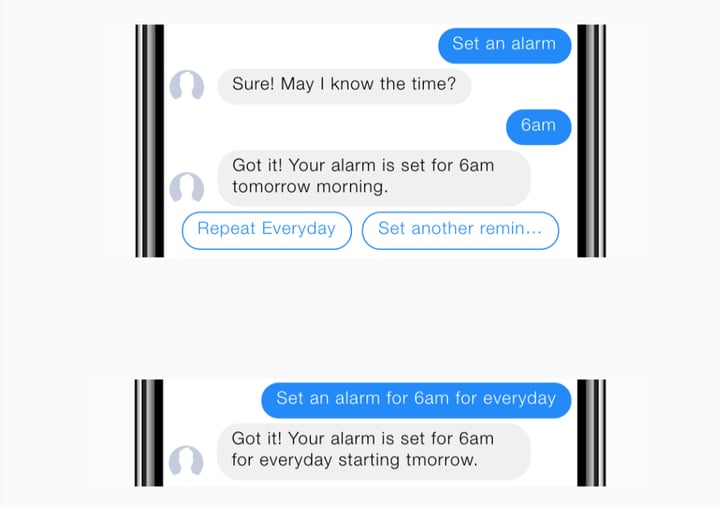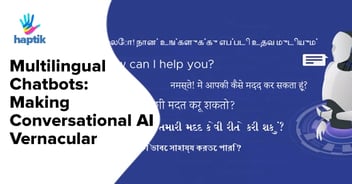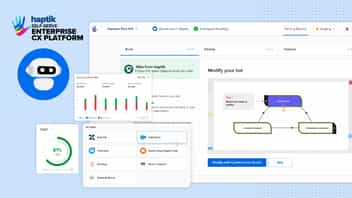Any company that claims leadership in its industry invests considerable time and resources in enhancing the usability of its products for the end-consumer. As one of the world’s leading Conversational AI companies, Haptik is no exception to this!
At Haptik, we have over half a decade of experience with building and designing chatbots – initially for our direct-to-consumer personal assistant app, and subsequently as a solutions provider for large enterprises. Over time we have scaled up and evolved our platform, and optimized our solutions, to deliver first-rate conversational experiences.
Our UI/UX design teams have adopted the best practices from the industry to make our Conversational AI solutions as user-friendly as possible. Read on to learn about usability heuristics for chatbots, and how we apply these principles at Haptik.
What are Usability Heuristics?
According to ISO 9241–11, usability is “the extent to which a product can be used by specified users to achieve specified goals with effectiveness, efficiency, and satisfaction in a specified context of use.”
Be it any technology/interface/medium/product/service, users will prefer you over your competitors if you provide a good user experience.
Usability Heuristic evaluation is a problem-solving approach that can be utilized to achieve a certain goal. In our case, usable chatbots.
There are innumerable ways to measure the usability of a product. The most common and identified method is Jacob Nielson’s heuristic principles. Jacob Nielson came up with 10 heuristic principles which can be utilized to evaluate the usability of a product. Here are the heuristics, applied in the context of conversational design:
Heuristic 1 – Visibility of system status
Users need to know how long it will take to complete the flow, how far into the flow they have progressed, and how much of the flow they have yet to complete.
In the above example, “Just 2 more questions to go” makes the user aware of the status of the quiz.
This will help the user stay engaged with the conversation and avoid drop-offs.
There are instances where the chatbot has to retrieve data from external sources which might take some time. This is a technological constraint, which should be accounted for “by design”. Making the loading (data fetching) a part of the experience is what good conversational design should do.

In the above example, “Sure. Hold on while I take a peek outside.” informs the user of the loading states and that he/she will have to wait for some time.
Heuristic 2 – Match between system and the real world
When a user isn’t sure about your jargon, you should be prompt in assisting them. Make the dialogue convenient for the user.

In the above example, “You can find it in the cash receipt” advises a user to know what lab/visit id means and how to find it.
Keeping the content of the conversation natural and familiar will help the users to complete their tasks smoothly.
Heuristic 3 – User control heuristics and freedom
Knowing about the risk is significant for the user. Sometimes, having an extra step helps a user to take a moment and evaluate if he should go ahead with the proposed direction.

Here, “Shall I go ahead & place the order” gives the ability to the user to take actions based on the outcome of his/her initial intention. It’s an extra step, which gives him the liberty to take a step back and return with a clearer intent.
Heuristic 4 – Consistency and standards
Companies choose colors and typography to depict their values through branding on apps and websites. But a bot is an active example of the brand’s voice in action. Conversational AI exhibits the personality of a brand in ways that traditional websites and ads typically cannot. Thus, chatbots can be a powerful tool when it comes to establishing a brand identity.
Indeed, a major reason why chatbots are used by various industries is due to their power of displaying the voice of the brand, aka “Voice Branding”.

In the above example, the humbleness, courtesy and responsibility for the user is visible throughout. It’s employed in every situation where ever applicable. The use of “Namaste Ji” is a great example of the curation of copy as per the target audience.
Heuristic 5 – Error prevention
A good design constantly works towards preventing the error from occurring in the first place.

Human users can make mistakes. A chatbot, on the other hand, has the potential to be intelligent enough to conclude that “gmaik” was a typo made by the user and give the user an opportunity to correct the error, as seen in the example given above.
Heuristic 6 – Recognition rather than recall
Emojis make their meaning immediately apparent, and are the quickest way to consume information while reading. They are prominent enough to break the monotony of the text. They require no reading effort, and thus helps the user recognize the intention of the text, rather than recalling and processing it. But use emojis wisely and effectively, otherwise, they will lose their importance.

In the above example, the “🔴 Red” and “🔵 Blue” are clearly recognizable due to the use of emojis.
Heuristic 7 – Flexibility and efficiency of use
Chat as an interface is very useful when it comes to providing accelerators.
Accelerators are basically shortcuts that allow more experienced users to skip the usual flow.
Sometimes it is necessary to create longer flows to help new users understand the service provided by the bot properly. But this turns out to be a hindrance for experienced users. Thus, accelerators help experienced users to skip parts of the flow and jump to the main intention.
In the above example, a user sends messages one after the other. The chatbot replies with the appropriate response, providing options like repeating the alarm every day.
But, once a user learns how things work, the next time, he/she directly types out the whole command in one go, which helps them achieve their objective i.e. setting the alarm, faster.
Heuristic 8 – Aesthetic and minimal design
In conversational design, aesthetics and minimalism can be attained by the simplicity and preciseness of the content.
Whenever users are consuming the content in a conversational interface, make sure it’s to the point and crisp


And if we talk about the usability of content consumption in chatbots, here’s a cheat sheet to get it right:

Heuristic 9 – Help users recognize, diagnose, and recover from errors
In automated conversational design, there will be situations where the chatbot will not be able to understand what the user is saying. That’s in the very nature of AI – the product has to embrace the chances of errors and randomness of the outcome. Thus, the chances of errors are natural in AI-enabled solutions.
In such cases, make sure you give a way out to the user and help him/her with the next possible actions
Heuristic 10 – Help and documentation
Make sure you have human assistance available to answer detailed user queries. If it’s not possible, have proper documentation links and contact links to help users know more about the topic.
67% Users Prefer Virtual Assistants with a 'Friendly' Personality. Read more on the impact of chatbot personality on customer experience.
To sum up…
If a Conversational AI solution is designed well, it is likely to drive long-term engagement with the user. UX fundamentals for designing chatbots are just like designing any website/app. The difference is that buttons, switches, and tabs are replaced by content and chat elements in conversational design.
Chatbots cannot be used to do anything and everything. It is important to identify what they can help users effectively accomplish, and deploy them for that purpose. And applying these appropriate heuristics Haptik is a great way to design Conversational AI solutions that truly deliver value to the end-user.
That’s the way we ship great bots at Haptik!
This article has been penned by Vaibhav Verma, UX Lead at Haptik.
Are you interested in developing a Conversational AI solution for your business?

























































